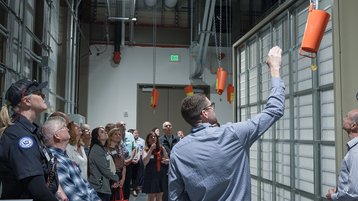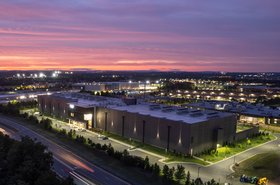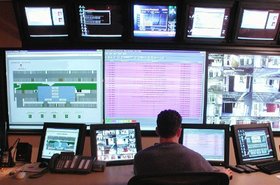When Sabey first set up in Quincy, Washington, the locals were understandably nervous.
One hundred miles east of Seattle, Quincy is in a rural region of Washington state, and the arrival of such a facility had the potential to turn their small community upside down.
It wasn’t the first – that was Microsoft – but the arrival of another indicated that it might be the start of something bigger.
“People don't like change, right? It's human nature. Quincy is a small, agriculture-based town, with lots of farmland, and the local economy, therefore, is mostly based on farming and associated services,” says Ryan Beebout, vice president – west, at Sabey Data Centers.
“So, when a big data center operator announces plans to move in, people are skeptical. We’re like the men in sharp suits coming over from the big city to take advantage of the town, or something like that, and if they continue to really feel that way, they can, and will, fight back in various ways,” he adds. “It may not be a majority of people, but it can be a very vocal and active minority.”
When Sabey moved to Quincy 15 years ago, its aim extended beyond building a data center campus that could serve the US western seaboard. It desired to become a fully supportive part of the local communities which its team members would call home.
Beebout, who lives in neighboring Wenatchee and works in Quincy, believes that Sabey’s approach to community engagement sets an example for data center operators everywhere. Providing high-paying employment opportunities in an exciting and fast-growing industry is only part of the value a local team can provide a region with.
“Since I joined Sabey in 2011, we’ve been very involved in the community, on charitable giving, working with schools, and on workforce development,” he says. Sabey’s work with education even extends to staff going into schools and colleges to help with technical education.
But the company is also pitching with projects that help the community, and don't directly benefit Sabey. “We've purchased new sound equipment for the football stadium, new uniforms for sports teams, rebuilt veterans or expanded a veterans’ memorial; we've purchased tablets and laptops for students, and we've supported education in many different ways; and, we regularly organize food drives for people in need in those communities,” says Beebout.
Data centers in the US also serve as a rich source of tax revenues for local authorities. “Data centers are highly capital-intensive buildings, full of equipment in the form of servers and networking equipment, all of which is taxed. There’s a property tax payable on all the servers, and real estate taxes on the buildings and infrastructure,” he says, noting that exact percentages can differ across state and county lines.
“Those tax receipts have greatly benefited the town. Quincy has seen its tax receipts balloon by a factor of ten in just 15 years, and it has been able to build the most amazing high school. You simply would not expect such a fantastic school in a small town. And, not only that, they’ve been able to renovate their middle schools and elementary schools, too,” says Beebout.
And that’s not all. Quincy can also boast a new library, new parks, new fire stations, and new police stations because of the tax dollars paid by Sabey and the other data center operators in Quincy. The population growth has not kept pace with the revenue growth, however, so Quincy has been able to preserve its small-town character as it reaps the financial benefits.
But it hasn’t meant a large influx of incomers taking the data center jobs ahead of locals. Indeed, points out Beebout, data center roles are highly diverse, and the majority can be filled by school leavers and career switchers, which is where Sabey’s own workforce development programs come in.
While that’s good for Sabey, it’s even better in terms of demonstrating that the data center is – and will always be – a source of good jobs for local people.
“Data centers employ a lot more people than they get credit for, but not so many that - if a data center moves into a small town - it’s going to completely overturn its makeup,” says Beebout.
“And that’s before taking into account the jobs provide by our tenants, the construction jobs on expanding data center campuses, and the community employment and prosperity that grows around a successful data center,” he adds.
At any one time, there may be around 300 employed at Sabey’s Quincy data centers, thanks to tenants’ own employees, and construction employment.
Community first
While the economy of the region remains primarily agriculture-based, data centers like Sabey’s have opened up new opportunities for high school graduates and career switchers.
“The great thing about most data center entry-level roles is that they don’t require a bachelor’s degree. We just need someone who’s graduated from high school and, perhaps, gone to community college or a trade school,” says Beebout. Instead, technical positions may require, say, a CompTIA certificate from college or even from highschool, and much of the rest can be learned on the job.
Then there are the various trade skills required to keep the data center ticking over on a day-to-day basis, particularly electrical, and heating and cooling (HVAC) trades. Indeed, if the local community has people qualified in some basic foundational skills, then the rest can be taught or picked up in the data center.
“We’ve found that finding people with the right prerequisites to work for us is not hard. Rarely does a candidate have data center-specific experience, and that hasn’t really been a problem. If candidates have other skills then we can teach them the specifics on the job,” says Beebout.
“What we’re looking for is their ‘soft’ skills. How effectively do they communicate? Are they driven? Do they work well on a team? Those are the main things we need in addition to the courses they took and passed in school or college.”
On top of that, he adds, Sabey also encourages career switchers. One of its senior managers in Quincy, for example, is a former banker who went back to school to skill up, get an IT degree, and got into data centers instead.
“The onus is on us to get out into the community, meet people, and to help them learn what a data center is, what jobs are available in our industry, and what those jobs are like because, ultimately, it’s an easy sell, but you just have to get out there and tell people about it,” says Beebout.
But the work Beebout and Sabey do in schools and colleges is not just about recruiting, but learning. “We go to schools to speak to students about what a data center career is like, we give tours to students, we even do job-shadows, and we help with mock-interviews. In a sense, we also help staff develop their technical curriculums,” says Beebout.
And it’s not just students who can benefit from the data center tours, but community leaders and other ‘local influencers,’ too. “We’ve found this helps tremendously in demystifying data centers. So often, there’s a lot of secrecy around data centers because of owner/operator policies, but I think this can do more harm than good. It helps build constructive relationships when you bring people in and just show them around,” says Beebout.
Long-term relationships
Data center providers build in new locations with the intention of staying for the long haul. Facilities are capital-intensive facilities with high upfront costs that require long-term leases to turn a profit.
Establishing solid, long-term relationships in the communities where data centers are located is the right thing for an ethically-minded company to do. But it also makes good business sense.
“You’re going to have to work with the city, county, or whatever authority is responsible for building codes. You have to work with the utilities because you’re going to need power, water, and possibly gas,” says Beebout. “In Washington State, for example, our diesel backup generators are regulated, so you’ll need permits to cover their emissions.
“If you come in and act like a bully and try to throw your weight around, you’re probably not going to get anywhere, and rightly so. But it’s far more effective if you’re humble and seek to build long-term relationships based on openness, trust, and honest dialog. You don’t have to hide anything, and you’ll encounter a lot less resistance in the long term.”
Sabey even goes as far as establishing relationships with small local businesses for the supply of goods and services, making good on the idea of keeping cash circulating to the benefit of the community.
Indeed, compared to some economic activities that might move to an area, data centers are generally clean, quiet, and disruption-free. Even the diesel generators are typically only powered up for the purpose of care and maintenance – and that’s just eight hours or so every year, according to Beebout.
But what about water usage, which is an especially sensitive issue in a rural location? While many column inches may have been written about this, Beebout believes it is not nearly as big an issue as many have suggested.
“If you do utilize evaporative cooling, you’ll be treating the water, filtering it, and perhaps using some kind of chemical to prevent the risk of any biological growth. But even that will be in tiny amounts and absolutely safe to flush into the sewer, and won’t be polluted,” he says.
Even this is already becoming a thing of the past before it can become a big issue. "Increasingly, this water is recycled back to the data center to reduce the water demand on the municipality. Even better, our new data centers don't even use water for cooling," says Beebout.
Similarly, countless headlines have been written calling out data center power consumption, but too few highlight the positive benefits of the industry, says Beebout.
It's in the data center operator’s best interest to run as efficiently as possible. As such, data center owners and end-users put a lot of effort and investment into systems and innovations that improve efficiency. The end result is that the amount of computing power per unit of electricity consumed is maximized.
Then there are the efficiencies driven by data center operators, aggregating inefficient corporate data centers into highly efficient facilities, and the savings generated for government and businesses alike by the digitalization that data center operators have helped support.
The right move
As data centers get ever more efficient, they must also continue to work with the communities in which they operate. And that requires celebrating what they can offer.
The high-average wage jobs generated by facilities like Sabey’s provide security and stability to the community. Taxes are re-invested to improve schools, provide enhanced services, and support other endeavors.
Indeed, as AI drives unprecedented data center demand all over the world, data center operators need to do more to emphasize why these facilities are important to everyone and the benefits they bring to the community: not just the secure employment for people across a wide range of skills, but the prosperity, the sustainability and, increasingly, the positive engagement and contribution of companies like Sabey.
To find out more about Sabey Data Centers, its locations, and what it is doing for local communities, go here.







